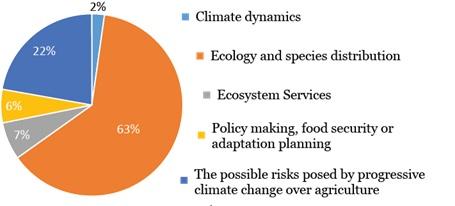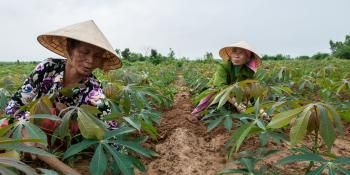Data for better understanding the changing climate

Climate data portal is the go-to place for understanding the effects of climate change on agriculture.
By Carlos Navarro
The CCAFS-Climate portal emerges at a time of growing need for high-resolution climate data to assess the impacts of climate change on agriculture. Global Circulation Models (GCMs) are one of the few tools researchers currently have to study the effects of long-term progressive climate change; however, their outputs are still too coarse to assess impacts on the environment. Thus, the CCAFS-Climate data portal aims to produce and offer high resolution climate data, updated and easy-to-access, for researchers and non-researchers who use the data in applications ranging from biodiversity and agriculture (especially crop modeling and agro-climatology) to ecosystem functioning. The portal now houses global datasets of climate change projections downscaled using several methodologies.

Percentage of publications using CCAFS-Climate data in different fields of application. Most of the downloaded data is being used by scientific researchers, and its use includes a number of impact studies which generated greater understanding of these topics.
Data in the hands of non-scientists

The portal has successfully moved beyond its immediate sphere of influence and now has a broad, multidisciplinary and global user base that employs the data to support impact and adaptation analyses.
Although the majority of data downloads from the platform are from scientists in academia and research institutes, CCAFS-Climate is also having significant impact by putting high resolution climate change information in the hands of non-climate scientists and next users, which represent up to 19% of all CCAFS-Climate users (e.g. NGOs, foundations, non-research international/national organizations, donors and governmental institutions). The portal has successfully moved beyond its immediate sphere of influence and now has a broad, multidisciplinary and global user base that employs the data to support impact and adaptation analyses in multiple target and non-target CCAFS sectors.
Specifically, non-scientific users report that CCAFS-Climate data were used for:
- Generation of early warning information for government use.
- Studies of climate change at the country-level for informing decision makers.
- Government planning purposes.
- Informing crop insurance policy development and water policy development.
- Agro-climatic and vulnerability assessment, especially in developing countries.
- Adaptive capacity enhancement in developing countries.
Understanding downscaled climate modeling in order to create more robust impact assessments.
CCAFS-Climate in numbers
From its creation, the total number of visits to the portal has reached more than 100,000 and the total number of downloads 470,000. About 2,200 institutions from 185 countries have used the portal for a range of purposes. The users included around 400 non-research institutions from 60 countries, indicative of the portal’s popularity outside of the research community.

At present, more than 100.000 people have visited the portal and more than 300 publications have been published using the CCAFS-Climate downscaled data.
Refereed publications using CCAFS-Climate data have also ascended to more than 300. Only last year (2014), there were 135 citations using data from the CCAFS-Climate portal (3 times more than 2013), including 6 book chapters, 21 theses & reports and 108 peer-reviewed articles. See these studies and more in the Citations section.
What can we expect in the future?
Given the importance of this portal for supporting impact and adaptation analyses, by the end of 2015, we plan to make available climate data in the format of common crop models (i.e. DSSAT and APSIM), in order to help facilitate the use of the data in crop modeling studies. This involves the development of an improved interface which allows for the display and query of raw GCM data from CMIP5 and processed daily data with several bias-correction methodologies. It would likely increase its use amongst crop modelers in general and therefore increase the website impact.
Other new datasets and functionalities are upcoming.
For more information please contact us, or:
- Visit the CCAFS-Climate online portal
- Download CCAFS-Climate flyer
- Visit Spatial Downscaling Methods: CCAFS-Climate Data Portal
The blog was written by Carlos Navarro, research assistant at CIAT.



